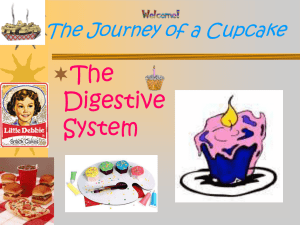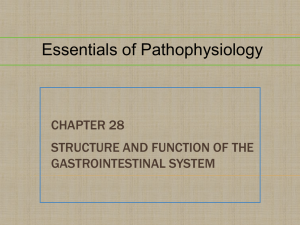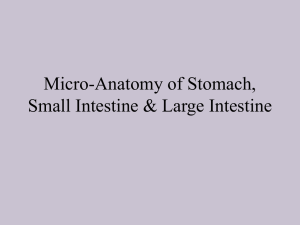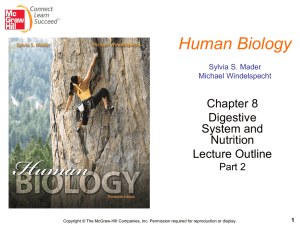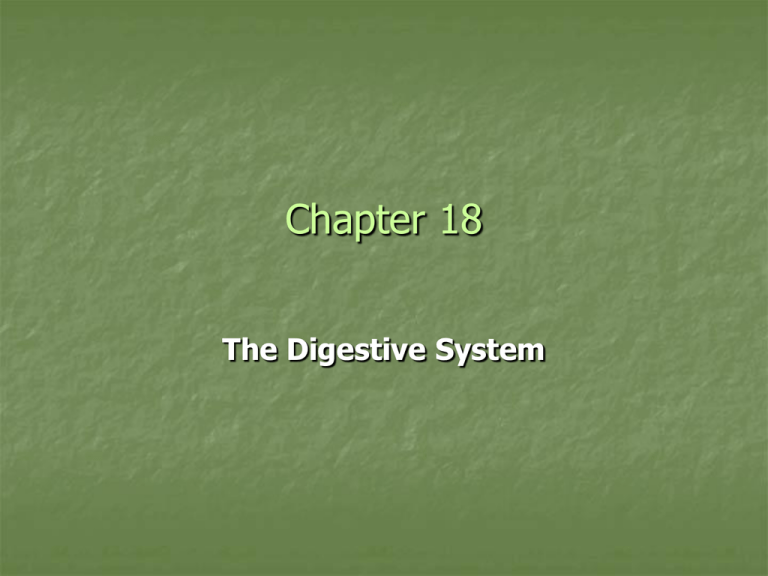
Chapter 18
The Digestive System
Functions of the GI Tract
Motility:
Movement of food through the GI tract.
Ingestion:
Taking
food into the _______________.
Mastication:
Chewing the food and mixing it with saliva.
_______________________:
Swallowing the food.
Peristalsis:
Rhythmic wave-like contractions that move
food through GI tract.
Functions of the GI Tract
Secretion:
(continued)
Includes both _____________ and endocrine
secretions.
Exocrine:
HCl, H20, HC03-, bile, lipase, pepsin, amylase,
trypsin, elastase, and histamine are secreted
into the lumen of the GI tract.
Endocrine:
Stomach and small intestine secrete hormones
to help regulate the GI system.
Gastrin, secretin, CCK, GIP, GLP-1,
guanylin, VIP, and somatostatin.
Functions of the GI Tract
Digestion:
Breakdown of food particles into subunits
(__________________ structure change).
Absorption:
(continued)
Process of the passage of digestion
(chemical subunits) into the blood or
lymph.
Storage and elimination:
Temporary storage and elimination of
indigestible food.
Digestive System (GI)
GI tract divided into:
Alimentary canal.
Accessory digestive organs.
GI tract is ______ft long and
extends from mouth to anus.
Crop found in birds
and other lower
animals
Layers of GI Tract
Composed of 4 tunics:
Mucosa.
Submucosa.
Muscularis.
Serosa.
Mucosa
Lines the lumen of GI tract.
Contains:
Connective tissue & lymph nodules.
Thin layer of smooth muscle responsible for the
folds.
Goblet cells:
Secrete _______________.
Submucosa
Contains blood vessels, lymph, and
nerve fibers
Absorbed molecules enter the blood and
lymphatic vessels.
Submucosal plexus (Meissner’s plexus):
Provide autonomic nerve supply to the
muscularis mucosae.
Muscularis
Responsible for segmental contractions and
peristaltic movement through the GI tract.
Inner circular layer of _________ muscle.
Outer longitudinal layer of smooth muscle.
Contractions of these layers move food
through the tract; pulverize and mix the food.
Major nerve supply to GI tract.
Fibers and ganglia from both sympathetic and
parasympathetic nervous systems.
Enterogastric Reflex: (_____________)
Enterogastric Reflex: (pacemaker)
Type of food determines rate of passage in
gut
High fat meal – may be in GIT ____ or more
hours
High COH – may be out by ____ hours
Serosa
Binding and protective outer layer.
Regulation of the GI Tract
Extrinsic innervation:
Parasympathetic nervous system:
Vagus and spinal nerves:
Stimulate motility and GI secretions.
Sympathetic nervous system:
Reduce peristalsis and secretory activity.
_______________: constriction of the guy at one
point on its length initiates constriction at a
neighboring point – wave
_______________: constrictions of circular
muscles appear and disappear in patterns that
push the contents back and forth
Regulation of the GI Tract
Submucosal and myenteric plexuses:
Paracrine secretion:
Local regulation of the GI tract.
Molecules acting locally.
Hormonal secretion:
Secreted by the mucosa.
(continued)
From Mouth to Stomach
Mouth
Tongue: in herbivores, tongue grasps
food and brings it in
Rough surface: papillae, providing traction
for moving food
Bringing food into mouth is voluntary
Mouth
________________: decreases particle size
and mixes with saliva which contains salivary
amylase.
Enzyme that can catalyze the partial digestion of starch.
Makes food into a bolus
________________: important in ruminants(regurgitation)
Ruminants take in large amounts of food in a short
period of time
Saliva
Glands: 3 major paired glands in mammals
Ruminants have 4th: Inferior molar
1. Parotid: below and front of ear
2. Mandibular – under jaw
3. Sublingual – under tongue
____________ – small glands
Saliva – pH = 6-7
Functions: Lubricant
Dissolves some food
Taste
Saliva
Composition of saliva:
1. Water: 98-99%
2. ______________
3. ______________________ – starch splitting
4. Sodium bicarbonate, phosphate
found in humans, horses, swine and dogs (not ruminants)
Starts COH digestion
buffers stomach
Ruminants: large amount of saliva
Important in ___________________recycling
Saliva formation
From Mouth to Stomach
__________________ (swallowing):
Begins as a voluntary activity.
Cannot be stopped.
Larynx is raised.
Epiglottis covers the entrance to respiratory
tract.
From Mouth to Stomach
(continued)
Esophagus:
Muscular tube – passes through thoracic
cavity and diaphragm to the ________ of
the stomach
Normally closed, stretches open when a
bolus of food passes through
Sits on the _________ side of the trachea
Connects pharynx to the stomach
Can observe bolus transport in cattle
Esophagus
Peristalsis:
Wave-like muscular
contractions:
Circular smooth muscle
contract behind, relaxes in
front of the bolus.
_______________
Sphincter: muscle that opens
and closes
Physiological barrier between
esophagus and stomach
Insert 18.4a
Ruminant Stomach
________________ animals
Digestive system
Large, lots of space for processing large
quantities of bulky forage
4 chambers of stomach:
__________________________________
4-compartments of ruminant; only one stomach
Ruminant Stomach
Reticulorumen
Large structure for fermentation of cellulose
@ 1 billion bacteria & 1 million protozoa per milliliter
________________% of total digestion occurs here
___________ secretory function
Does have _________________ function
Composed of smooth muscle with vagus
innervation
Blood from reticulorumen
portal vein – liver
Digestion in ruminant
Carbohydrates – cellulose
Microbe population
volatile fatty acids (_______________________________)
absorbed across rumen wall
Proteins – digested by _____________
Lipids – also broken down
Microbes in rumen synthesize all ______complex
vitamins and all ____________ amino acids
Ruminant Stomach
__________ – common to both the rumen
and reticulum (where they sort of meet)
esophageal groove
Extends from the cardia to the omasum
Formed by two heavy muscles
Can close to allow food to go directly from the
esophagus to the _______________
__________________
Omasum
Epithelium has leaflike folds
Enormous ________________ ability
Abomasum
True stomach
similar to monogastric stomach with some
secretory ability
Has a _______________ sphincter
Non- Ruminant Stomach
Most distensible part of GI tract.
Empties into the duodenum.
Functions of the stomach:
____________________.
Initiates digestion of ____________.
Kills bacteria.
Moves food (chyme) into intestine.
Stomach
Contractions
of the
stomach
churn chyme.
Mix chyme
with gastric
secretions.
Push food
into
intestine.
(continued)
Insert fig. 18.5
Stomach
Gastric mucosa
has gastric pits
in the folds.
Cells that line
the folds
deeper in the
mucosa, are
gastric glands.
(continued)
Insert fig. 18.7
Stomach
Non Ruminant Stomach (_________)
(continued)
Exterior Subdivided into:
1. Cardia (entrance)
2. Fundus
3. Body
4. Pylorus (termination) (aka: antrum; constricted
part) joins to duodenum
Cardia and pylorus act as sphincters to control
passage of food
Stomach
Interior Subdivided into:
1. Esophageal Region (non glandular;
compares to fore-stomaches in rum)
large in horse, small in pig
2. Cardiac-gland region (sometimes called
gastric gland region)
(continued)
large in pig, smaller in horse
3. ________________-gland region
4. Pyloric-gland region
Surface is folded into depressions or gastric
pits, increases surface area
Horse
Rabbit
Hindgut Fermenters
Both Rabbit and horse are monogastrics
Rabbit – Produce “hard” and “soft” feces
Hard – “rabbit pellets”
Soft – material from _________ this is enclosed
in mucous membrane that passes through the
hindgut and is eaten by the rabbit as it emerges
from the anus
Gastric Glands
Secrete gastric juice:
Goblet cells: mucus.
Parietal cells: _____________________.
Chief cells: pepsinogen.
Pyloric (G cells): gastrin.
Stomach: ______________________.
Parietal cells secrete
________
Chief cells secrete___________
HCl Production
HCl production is stimulated:
Indirectly by ____________
Makes gastric juice very acidic.
(continued)
Makes proteins become more digestible.
Activates pepsinogen to pepsin.
Pepsin is more active at pH of 2.0.
HCl Functions
Insert fig. 18.9
Digestion and Absorption in the
Stomach
Proteins partially digested by______.
Carbohydrate digestion by salivary amylase
is soon inactivated by acidity.
_______________________ are the only
commonly ingested substances absorbed.
Protective Mechanisms of Stomach
Parietal and chief cells impermeable to
____.
Alkaline mucus contains HC03-.
Tight junctions between adjacent epithelial
cells.
Rapid rate of cell division (entire epithelium
replaced in 3 days).
___________________ inhibit gastric
secretions.
Small Intestine
Each villus is a fold in
the mucosa.
Covered with columnar
epithelial cells
interspersed with goblet
cells.
Epithelial cells at the tips
of villi are exfoliated and
replaced in crypt of
Lieberkuhn.
Lamina propria contain
lymphocytes, capillaries,
and central lacteal.
Insert fig. 18.12
Absorption in Small Intestine
(most absorption occurs here)
Duodenum and jejunum:
Carbohydrates, amino acids, lipids, iron, and
Ca2+.
Ileum:
Bile salts, vitamin B12, electrolytes, and H20.
Small intestine
Intestinal Enzymes
Microvilli contain brush border enzymes that
are not secreted into the lumen.
Absorption requires both brush border
enzymes and pancreatic enzymes.
Small intestine
Small intestine
Pancreas
In close proximity to Duodenum
Release proteases (__________ enzymes)
__________________ (starch spitting)
Lipases (fat breakdown) + bicarbonate
(buffer)
Opens into duodenum near the common bile
duct
Large Intestine
Outer surface bulges outward to form ______.
Little absorptive function.
Absorbs H20, electrolytes, several vitamin B
complexes, vitamin K, and folic acid.
Intestinal microbiota produce significant amounts
of folic acid and _________________.
Bacteria ferment indigestible molecules to produce
short-chain fatty acids.
Does not contain villi.
Secretes __________, via active transport of
NaCl into intestinal lumen.
Fluid and Electrolyte Absorption in the
Intestine
Small intestine:
Most of the fluid and electrolytes are absorbed by small
intestine.
Absorbs about 90% of the remaining volume.
Absorption of H20 occurs passively as a result of the
osmotic gradient created by active transport.
Aldosterone stimulates NaCl and H20 absorption in
the ileum.
Large intestine:
Absorbs about ________ of the remaining volume.
Absorption of H20 occurs passively as a result of the
osmotic gradient created by active transport of Na+
and Cl-.
Defecation
Waste material passes to the rectum.
Occurs when rectal pressure _________ and
external anal sphincter relaxes.
Defecation reflex:
Longitudinal rectal muscles contract to increase
rectal pressure.
Relaxation of internal anal sphincter.
Excretion is aided by contractions of abdominal
and pelvic skeletal muscles.
Push feces from the rectum.
Structure of Liver
Liver _________ internal organ.
Arranged into functional units called
lobules.
Plates separated by sinusoids.
Secretes ________ into bile canaliculi,
which are drained by bile ducts.
Structure of Liver
(continued)
Insert fig. 18.20
Hepatic Portal System
Products of digestion that are absorbed
are delivered to the liver.
Capillaries drain into the hepatic portal
vein, which carries blood to liver.
¾ blood is deoxygenated.
_____________ vein drains liver.
Enterohepatic Circulation
Compounds that
recirculate
between liver and
intestine.
Many compounds
can be absorbed
through small
intestine and enter
hepatic portal
blood.
Insert fig. 18.22
Major Categories of Liver Function
Bile Production and Secretion
The liver produces and secretes 250–1500 ml of bile/day.
Major constituents of bile are
Bile pigment (bilirubin) - also produced in the spleen and bone
marrow
Bile salts
Phosholipids
_________________________
Inorganic ions
Metabolism of Heme and Bilirubin
Free ____________is not water soluble
Must be carried by______________________
Bound cannot be filtered by kidneys or excreted by liver
in bile
Conjugated bilirubin – combined with glucuronic
acid
Enters intestine and converted by bacteria to
urobilinogen
Brown color to_____________________
Absorbed by circulation = __________________ color to urine
Metabolism of Heme and Bilirubin
Insert fig. 18.23
Jaundice
Bile Production and Secretion
Bile acids are
derivatives of
___________.
Insert fig. 18.25
Major pathway of
cholesterol breakdown
in the body.
Bile salts
micells FFA,
monoglycerides,
cholesterol
diffuse across
membrane.
(continued)
Major bile salts
Bile
Bile congregates to form __________
Nonpolar = central area – away from water
Polar = outer area – loves water
Emulsify and allow for transport of cholesterol
and other lipids
Production of bile from cholesterol is
________ pathway of cholesterol
breakdown
Detoxification of the Blood
Liver can remove hormones, drugs, and
other biologically active molecules from the
blood by:
Excretion into the ________.
Chemical alteration of the molecules.
___________________is produced by deamination
of amino acids in the liver.
Liver converts it into urea.
Excreted in urine.
Detoxification of the Blood
(continued)
Inactivation of steroid hormones and
drugs.
Hydroxylation (addition of OH-) groups
Makes hormones more polar-excreted in
urine
Bile Production and Secretion
(continued)
Triglycerides formed in epithelial cells –
encased in protein coat (chylomicrons) –
enter lacteals
All _________ is digested/absorbed in
upper part of small intestine.
Secretion of Glucose, Triglycerides
and Ketones
Liver helps regulate blood glucose
concentration by:
Glycogenesis and lipogenesis.
Glycogenolysis and gluconeogenesis.
Contains enzymes required to convert free
fatty acids into _________ bodies.
Production of Plasma Proteins
Albumin and most of the plasma globulins
(except immunoglobulins) are produced by
the liver.
Albumin:
Constitutes 70% of the total plasma protein.
Contributes most to the ___________ osmotic
pressure in the blood.
Globulins:
Transport cholesterol and hormones.
Inhibit trypsin.
Produce blood clotting factors
Gallbladder
Sac-like organ attached to the inferior
surface of the liver.
Stores and concentrates bile.
When gallbladder fills with bile, it
expands.
Exocrine:
Acini:
Secrete
pancreatic
juice.
Endocrine:
Pancreas
Islets of
Langerhans:
Secrete
insulin and
glucagon.
Insert fig. 18.26
Pancreatic Juice
Contains H20, HC03- and digestive enzymes.
Pancreatic Juice
Complete digestion
of food requires
action of both
pancreatic and brush
border enzymes.
Most pancreatic
enzymes are
produced as
zymogens.
Trypsin (when
activated by
enterokinase)
triggers the
activation of other
pancreatic enzymes.
Pancreatic trypsin
inhibitor attaches to
trypsin.
Inhibits its activity in
the pancreas.
Fig. 18.29
Neural and Endocrine Regulation
Neural and endocrine mechanisms modify
the activity of the GI system.
GI tract is both an ____________ gland,
and a target for the action of hormones.
Regulation of Gastric Function
Gastric motility and secretion are automatic.
Waves of contraction are initiated
spontaneously by pacesetter cells.
Extrinsic control of gastric function is divided
into 3 phases:
Cephalic phase.
Gastric phase.
Intestinal phase.
Cephalic Phase
Stimulated by sight, smell, and taste of food.
Activation of vagus:
Stimulates chief cells to secrete _________.
Directly stimulates G cells to secrete gastrin.
Directly stimulates ECL cells to secrete
____________________
Indirectly stimulates parietal cells to secrete
HCl.
Gastric Phase
Arrival of food in stomach stimulates the gastric
phase.
Gastric secretion stimulated by:
Distension.
Chemical nature of ___________(amino acids and
short polypeptides).
Stimulates G cells to secrete gastrin.
Stimulates chief cells to secrete pepsinogen.
Positive feedback effect.
As more HCl and pepsinogen are secreted, more
polypeptides and amino acids are released.
Gastric Phase
Secretion of HCl is also
regulated by a
negative feedback
effect:
HCl secretion
decreases if pH < 2.5.
At pH of 1.0, gastrin
secretion ceases.
(continued)
Insert. Fig. 18.30
Intestinal Phase
Inhibits gastric activity when chyme
enters the small intestine.
Activates sensory neurons of _________
and produces an inhibitory neural reflex:
Inhibits gastric motility and secretion.
In the presence of fat, enterogasterone inhibits
gastric motility and secretion.
Hormone secretion:
Inhibit gastric activity:
Somatostatin, CCK, and GLP-1.
Enteric Nervous System
Submucosal and myenteric plexuses
contain 100 million neurons.
Include preganglionic parasympathetic
axons, ganglion cell bodies,
postganglionic sympathetic axons; and
afferent intrinsic and extrinsic sensory
neurons.
Controls peristalsis and segmentation
Paracrine Regulators of the
Intestine
Serotonin (5-HT):
Motilin:
Stimulates intrinsic afferents, which send impulses into
intrinsic nervous system; and activates motor neurons.
Stimulates contraction of the duodenum and stomach
antrum.
Guanylin:
Activates guanylate cyclase, stimulating the production of
cGMP.
cGMP stimulates the intestinal cells to secrete Cl- and H20.
Inhibits the absorption of Na+.
___________________:
May stimulate kidneys to secrete salt in urine.
Intestinal Reflexes
Intrinsic and extrinsic regulation controlled by
intrinsic and paracrine regulators.
Gastroileal reflex:
Increased gastric activity causes increased motility of
ileum and movement of chyme through ileocecal
sphincter.
_____________________ reflex:
Distension of ileum, decreases gastric motility.
Secretion of Pancreatic Juice
Secretion of pancreatic juice and bile is stimulated by:
___________________:
Occurs in response to duodenal pH < 4.5.
Stimulates production of HC03- by pancreas.
Stimulates the liver to secrete HC03- into the bile.
__________________:
Occurs in response to fat and protein content of
chyme in duodenum.
Stimulates the production of pancreatic enzymes.
Enhances secretin.
Stimulates contraction of the sphincter of Oddi.
Digestion and Absorption of
Carbohydrates
Salivary amylase:
Pancreatic amylase:
Begins starch
digestion.
Digests starch to
oligosaccharides.
Oligosaccharides
hydrolyzed by brush
border enzymes.
Glucose is transported
by secondary active
transport with Na+
into the capillaries.
Insert fig. 18.32
Digestion and Absorption of Protein
Digestion begins in the stomach when pepsin
digests proteins to form polypeptides.
In the duodenum and jejunum:
__________________cleave peptide bonds in the
interior of the polypeptide:
Trypsin.
Chymotrypsin.
Elastase.
___________________cleave peptide bonds from
the ends of the polypeptide:
Carboxypeptidase.
Aminopeptidase.
Digestion and Absorption of Protein
(continued)
Free amino
acids
absorbed by
___________
______with
Na+.
Insert fig. 18.33
Digestion and Absorption of Lipids
Arrival of lipids in the duodenum serves
as a stimulus for secretion of bile.
__________________________:
Bile salt micelles are secreted into
duodenum to break up fat droplets.
Pancreatic lipase and colipase hydrolyze
triglycerides to free fatty acids and
monglycerides.
Digestion and Absorption of Lipids
(continued)
Free fatty acids, monoglycerides, and
lysolecithin leave micelles and enter into
epithelial cells.
Resynthesize triglycerides and phospholipids
within cell.
Combine with a protein to form chylomicrons.
Transport of Lipids
In blood, lipoprotein lipase hydrolyzes
triglycerides to free fatty acids and glycerol
for use in cells.
Remnants containing cholesterol are taken to
the liver.
Form VLDLs which take triglycerides to cells.
Once triglycerides are removed, VLDLs are
converted to LDLs.
LDLs transport cholesterol to organs and blood vessels.
HDLs transport excess cholesterol back to
liver.
Absorption of Fat
Insert fig. 18.36






